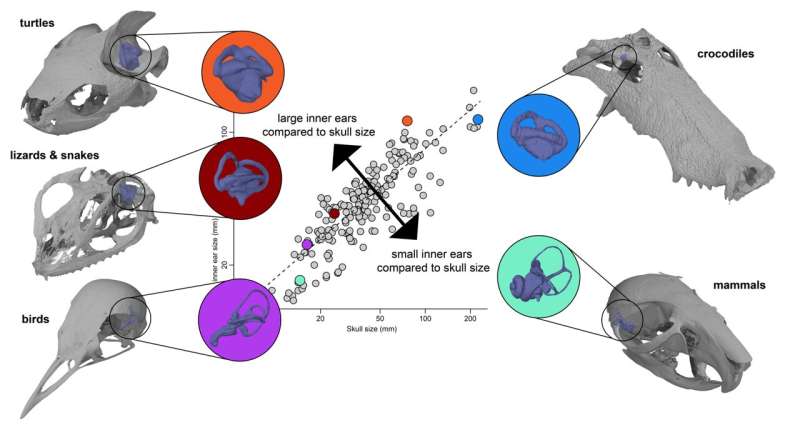October 12, 2022 report
Turtles found to have relatively large inner ears and unexpectedly large labyrinth morphology

An international team of researchers has found that turtles not only have relatively large inner ears, but unexpectedly large ear labyrinth morphology. In their paper published in the journal Nature Communications, the group describes their study of multiple species of turtles representing both living and extinct species.
The labyrinth, in biological terms, is a bony structure located within the inner ear of most animals. Inside, it has membranes that allow for detection of changes made by the head relative to its environment. It is the organ that makes balance possible. In this new effort, the researchers noted that most study of the labyrinth has been done in mammals. To learn more about the structure and its development history in reptiles, the team focused their attention on turtles.
The team studied the structure of the labyrinth in 90 species of turtle living today and 53 that have gone extinct. They also noted that prior research has suggested that the size of the labyrinth is generally dictated by the environment in which an animal lives. Birds, for example, have a large labyrinth on either side of their head to facilitate balance during agile flying maneuvers.
The researchers found that the size of the labyrinth in turtles began to grow shortly after they became swimmers. They also found that their inner ear parts in general grew larger and more complex. And they were surprised to find that the labyrinth had grown to such a size that it was bigger, relatively speaking, than most other vertebrates—similar in size, they note, to birds.
The findings go against theory—turtles are not known to be agile swimmers; thus, they would not be expected to have such a large labyrinth. This further suggests that factors other than the environment have an impact on labyrinth size. The researchers also found that the shape of the labyrinth in turtles does not correlate with ecology; this contradicts theories suggesting that the shape of the labyrinth in general plays a role in behavioral signaling. The researchers emphasize the importance of studying a wider group of animals before drawing conclusions about anatomical characteristics.
More information: Serjoscha W. Evers et al, Independent origin of large labyrinth size in turtles, Nature Communications (2022). DOI: 10.1038/s41467-022-33091-5
Journal information: Nature Communications
© 2022 Science X Network




















